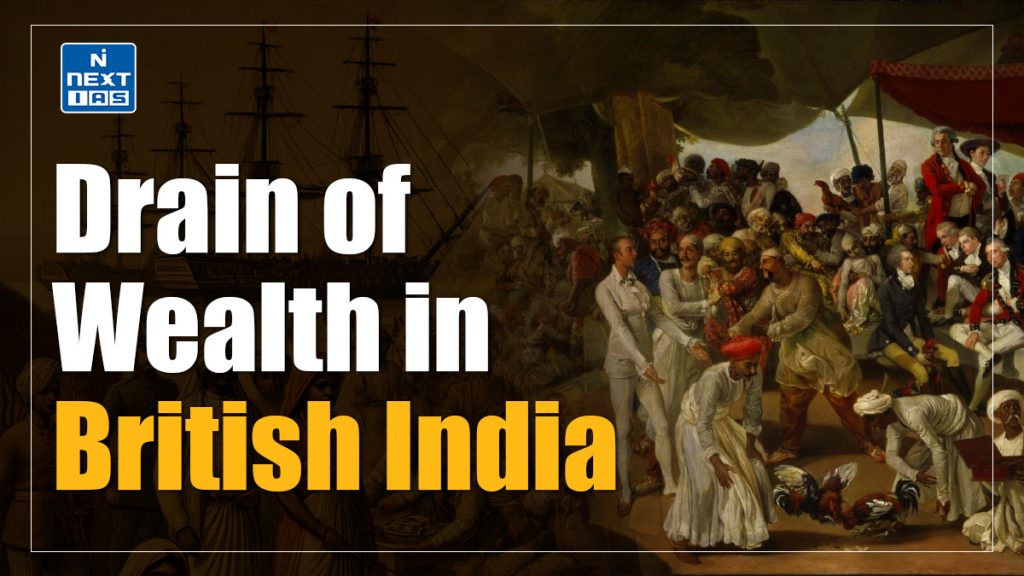
The Drain of Wealth theory refers to the systematic transfer of wealth from India to Britain through exploitative colonial policies, significantly impacting India’s economy. This drain impoverished the country, depriving it of resources necessary for its development and fueling resentment that became a rallying point for the freedom movement. This article aims to study in detail the concept, mechanisms, and impacts of the Drain of Wealth on India’s economy and society during British rule.
About Drain of Wealth in British India
- The term ‘drain of wealth’ refers to the unidirectional flow of a portion of wealth and resources from India to Britain, for which India received nothing in return.
- The drain of wealth from Bengal began in 1757 when the company’s servants began to carry home immense fortunes extracted from Indian rulers, Zamindars, Merchants and the common people.
- According to one estimate, they sent home nearly £ 6 million between 1758 and 1765.
- This amount was more than four times the total land revenue collection of the Nawab of Bengal in 1765.
- This amount did not include the company’s trading profits, often no less illegally derived.
- The drain took the form of an excess of India’s exports over its imports, for which India got no returns.
- The exact amount of the annual drain has yet to be calculated, and historians differ on its quantum. In fact, the drain, at least from 1757 to 1856, was widely accepted by British officials.
- The drain increased after 1858, though the British administrators and imperialist writers began denying its existence. By the end of the 19th century, it constituted nearly 6% of India’s national income and one-third of its national savings.
- The wealth drained of India was crucial in financing Britain’s capitalist development, especially during Britain’s early industrialisation in the 18th and beginning of the 19th centuries.
- It has been estimated that it constituted nearly two per cent of Britain’s national income during that period. This figure assumes importance given Britain’s investment of about seven per cent of its national income in industry and agriculture at that time.
Factors and Forces Behind Drain of Wealth
- The emergence of the company as a political power.
- The Colonial character of British rule put British economic interests before Indian interests.
- British never desired to settle down in India. Indian conquest was temporary for them.
- The British introduced a very complex administrative and legal system in India.
Mechanism of Drain of Wealth
- Investments: Under this system, the company used Indian resources to purchase goods from the Indian market and export them to Britain. The proceeds of these trades remained in Britain.
- Home Charges: This refers to expenditures incurred in England by the Secretary of State on behalf of India. They included dividends paid to shareholders of the East India Company, Interest on public debt raised abroad, civil and military charges, and store purchases in England.
- European Finance Capital: European ventures in India supported each other against Indian competition, and Indians were left out of economic activities. The government intervened only when they generated profit, and these profits were not invested in India.
Impact of Drain of Wealth Theory
- Consistent outflow of a significant portion of the Indian Gross National Product.
- It seriously affected the purchasing power of Indians.
- De-industrialisation of the Indian Economy.
- It completely Ruined traditional artisans/ craftsmen.
- Famines and poverty increased frequently and drastically, respectively.
- De-urbanisation of India.
Role of Dadabhai Naoroji
- One of the earliest proponents of the Drain of Wealth theory, Dadabhai Naoroji, extensively discussed it in his book, Poverty and Un-British Rule in India.
- He argued that India was losing wealth due to exploitative policies, which led to impoverishment and hindered India’s economic development.
- Dadabhai Naoroji’s work critically analysed how British policies systematically siphoned India’s wealth to Britain without fair returns, creating a lasting economic imbalance.
- He pointed out that British revenue policies, over-taxation, and the use of Indian resources to fund British military campaigns and administrative expenses in India further strained India’s economy.
- Naoroji described the “drain” as one of the main reasons behind India’s poverty, highlighting how it prevented reinvestment in agriculture, industry, and public welfare.
- His theory laid the groundwork for understanding colonial exploitation and rallied Indians toward the cause of self-governance and economic independence.
Significance of Drain of Wealth in Freedom Struggle
- The Drain of Wealth theory fueled Indian nationalism and united people across regions, religions, and castes under a shared cause.
- This economic critique underscored the demand for self-governance and financial independence, becoming a rallying point for leaders like Dadabhai Naoroji, Bal Gangadhar Tilak, and Mahatma Gandhi.
Conclusion
The Drain of Wealth theory played a crucial role in shaping the anti-colonial movement by exposing the economic impact of British policies on India’s prosperity. It highlighted the need for Indian autonomy over its resources and laid the intellectual foundation for the demand for Swaraj, or self-rule, influencing India’s struggle for independence.
Frequently Asked Questions (FAQs)
What is the Drain of Wealth?
The Drain of Wealth refers to the economic exploitation and transfer of wealth from India to Britain during the colonial period. This concept highlights how British policies systematically drained resources, capital, and profits from India, impoverishing the local economy while enriching Britain.
Who propounded the Theory of Drain of Wealth?
The Theory of Drain of Wealth was propounded by Dadabhai Naoroji, an Indian nationalist and economic thinker, in the late 19th century.






